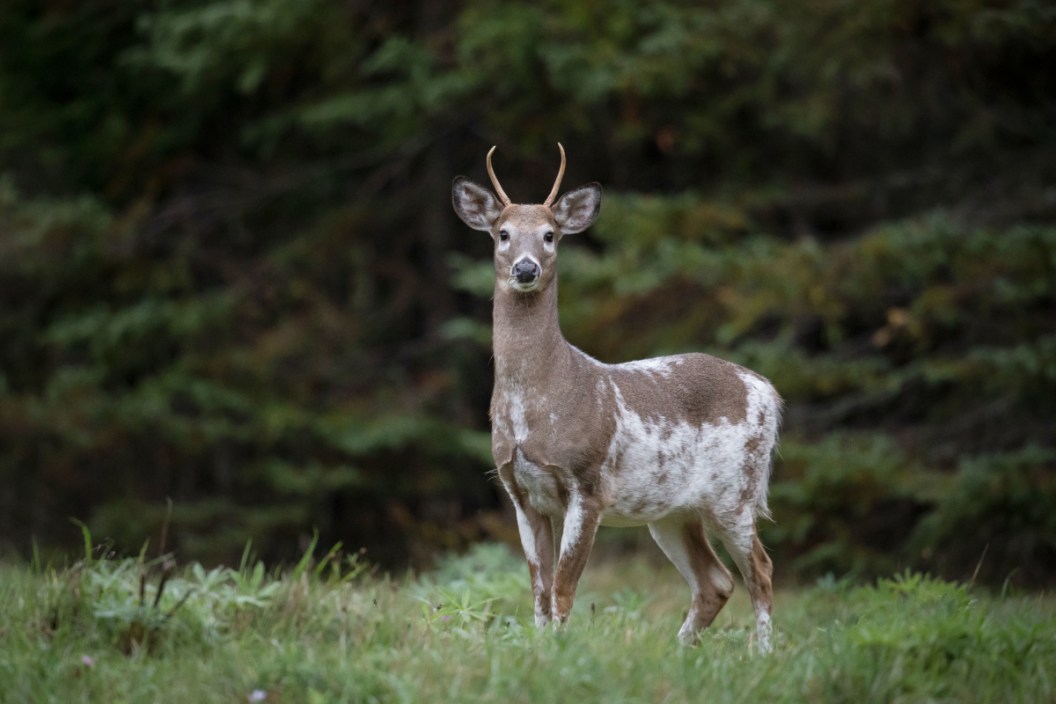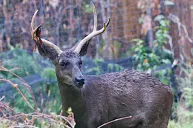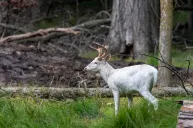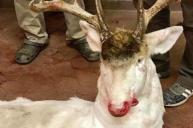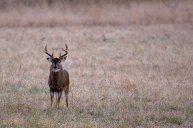Albino and piebald deer are some of the most beautiful and controversial deer any hunter can encounter. Debate rages: can you shoot an albino deer? Hunters often consider whether they deserve preservation or if it's better to remove them from the general deer population. So, we decided to look at all sides of the debate on these critters in depth. And the pros and cons of shooting one during deer hunting season. Let's examine the pros and cons of taking such unusual and rare animals from deer herds and whether it produces repercussions (legal or reputational) for hunters.
Causes of Albino & Piebald Deer
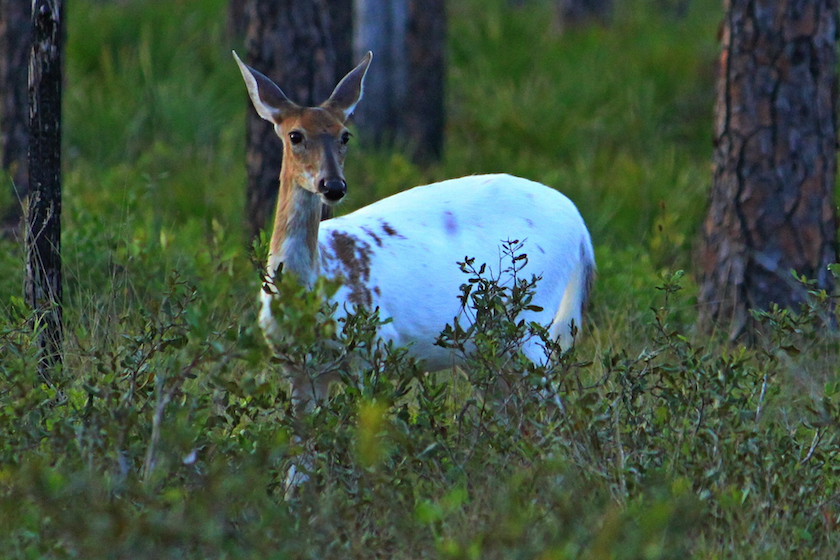
James Robert Smith via Getty Images
Albinism, leucism, and piebaldism are all caused by a recessive genetic trait that affects the pigment in a deer's hair. Both parents must carry the recessive gene for these abnormalities to occur. We often see albinism and leucism mixed up, with many hunters referring to any deer with white as "albino." Remember that a true albino will have pink eyes and a pink nose. At the same time, leucism often results in deer keeping their natural eye color, nose, and ears. If the deer has brown eyes, it's not a true albino.
Piebald deer are easy to identify and are the most common coloration you're likely to meet while hunting. The Quality Deer Management Association says this defect only occurs in around two percent of deer. Even at two percent, piebald deer aren't exactly a rare animal. I've had two run-ins with two different wild piebald whitetail deer. One was a young piebald doe I spotted a few miles from home that was almost entirely white. I only saw her once and then never again. The other was a young piebald buck that showed up on one of my trail cameras one summer. He had browner fur with white patches in his coloration. I only photographed him once in the summer as he crossed a creek, but I never encountered him in person. Another hunter later shot him during bow season.
When it comes to albino and leucistic deer, your odds of encountering them go down drastically. No matter the color pattern, these deer often have other deformities like short legs or spinal problems. Sometimes bucks grow misshapen antlers. They can also have a short "roman nose" or other defects in their jaws compared to healthy deer of normal coloration. A white (or partially white) deer is at a survival disadvantage, even if the coloration is the only defect it has. Human and natural predators can more easily spot lighter coats in the wilderness.
There is also another form of genetic variation in deer, and that's the melanistic variety. These animals have too much melanin in their pigment, causing them to take on a dark or even black appearance. The melanistic type is much rarer than albinos and piebald.
Can You Shoot an Albino or Piebald Deer?
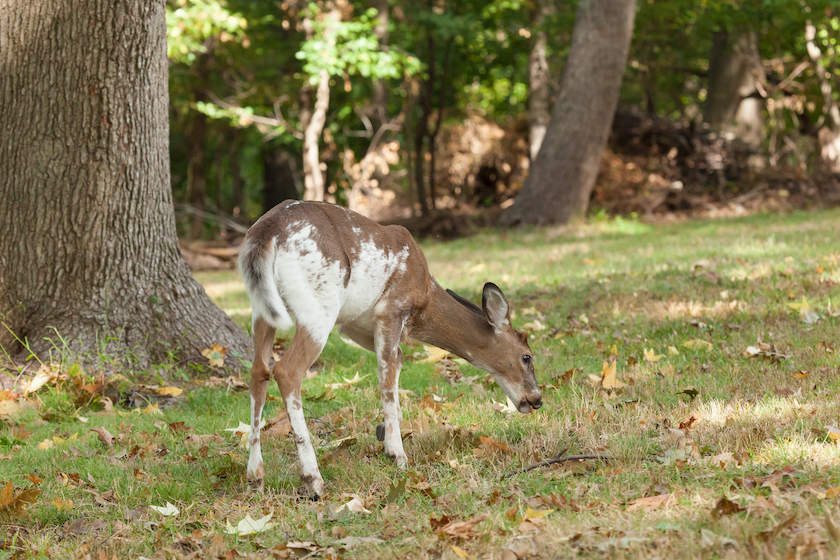
luvemakphoto via Getty Images
Most hunters will argue that you should take albino and piebald deer out of the herd because of genetic abnormalities. It's hard to argue against that because of the laundry list of health problems some white animals can have compared to their more naturally colored cousins.
In some cases, you might be doing the animal a favor if it has difficulty eating or walking from an arched spine. This is what deer management is about, right? Maintain the herd, keep it healthy and free from genetic mutations that may harm it. You'll find that most deer biologists agree with that sentiment. Still, many states had rules that protected albinos or piebald for a long time. For instance, it's been illegal to shoot albino deer in Michigan for a long time.
Only a few hunters knew this, however. It wasn't something that you could find in the book of regulations. Biologist recommendations probably led the DNR to drop that rule in 2008. After a high-profile incident where an 11-year-old boy shot a 12-point albino buck in 2014, the Michigan DNR deer program said that, despite public interest, there's no reason to protect these animals.
"There is no biological reason to protect the genetic trait that causes a deer to be all-white or albino," specialist Brett Rudolph told the Detroit Free Press.
Special rules protecting albino or piebald deer can also lead to unintended legal problems for hunters who don't realize they shot a protected animal. Such was the case for an otherwise-legal Wisconsin hunter last year who shot what was considered an albino deer.
It may seem odd for someone to claim to shoot one by mistake when he claims he knew the rule, but this guy self-reported the incident, so I'm inclined to believe the story. It's unfortunate because, other than the coloration, this was a standard deer. This guy didn't need punishment for an honest mistake.
There are high-profile cases of albino or piebald deer that lived long lives. There have been many famous albinos that lived to be mature bucks. But natural predators mercilessly kill just as many because they can't hide as easily. Let's face it, a bullet or arrow is a much more humane death than many wild animals will get. Why should a deer with white hair get preferential treatment and protection from hunters? Also, this is a once-in-a-lifetime type of harvest. Not many will get the chance to shoot such a unique animal.
Preserving Albino & Piebald Deer
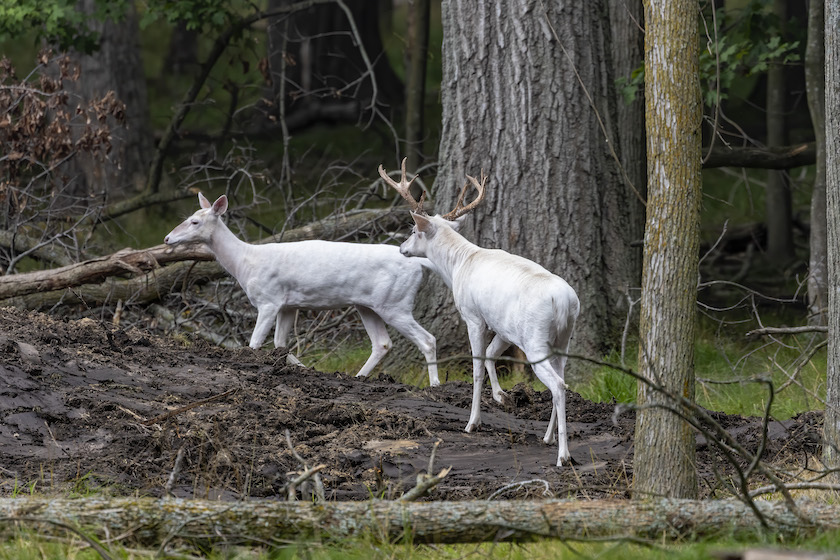
Karel Bock via Getty Images
While there are many reasons for shooting a white deer, there are just as many reasons to preserve them. You'll find that some hunters flat-out don't agree with it. I've heard many stories from hunters who've had deer like this in their sights and let them walk.
Some Native American traditions hold these deer sacred. So you might not see many native hunters taking the shot either. If you're not afraid of taboos or superstitions, there are other reasons to preserve these deer.
Take the Seneca Army Depot in New York as an example. The Seneca Army Depot was a former munitions storage facility the U.S. Army used for over 70 years. Incidentally, when the army fenced in the depot in the 1940s, so were at least two deer-either leucistic or carrying the gene. You can imagine what happened over the next few decades. With the herd isolated, the recessive gene spread quickly. Inevitably, the pack of white deer became a sensation. Private ownership eventually opened the depot to the public for tours just a few years back. The depot runs in Romulus, New York, where the residents might consider the white deer herd a good thing. The preserved pack will remain a source of tourist dollars for years.
Granted, that's a very unusual case. But let's face it, everyone loves a white or partially white deer. Albino deer draw crowds wherever they roam. And in my mind, anything that gets people into the outdoors is good.
While I've been fortunate to see one in the wild, plenty of others may never get that chance. Deer are a natural resource shared by all of us. But this is an unusual situation when a white deer is involved. Is it fair for one person to take away something unique most may never see? Honestly, I've struggled because it's a question without an easy answer. Again, you'll receive pushback from biologists on this. There has been a movement towards rolling back many laws put in place to protect these animals in recent years. But many people don't consider hunting's reputation when someone shoots one of these animals.
Every time someone shoots a piebald or albino, it causes a stir. Often the local media get involved, and pictures of the animal spread everywhere on social media. You'll also find that most of the hunters who shoot one regret sharing their success later. Some parts of social media mercilessly shame hunters for taking a piebald or albino deer. We can try to educate the public, but they aren't listening in most instances. All they see is a rare deer that's now dead.
For this reason, I sometimes wonder if we're simply better off not shooting them or, if we do, not sharing them with the public. The reputation of hunting is already shaky at best. You can double this when white animals are involved. The "Cecil the Lion" incident proved things are changing. People often throw hunters into a negative spotlight whenever someone shoots one of these animals. This dovetails into my last point.
There are more reasons to take these genetic anomalies out of the herd than to preserve them. You'll never actually cut these genes from any deer herd. But at the same time, I might not shoot one because of the impact on non-hunters. When I'm talking about non-hunters, I'm not talking about anti-hunters. The antis are already a lost cause, and I've already written extensively about why I gave up on caring about them. Instead, I'm talking about people who aren't against hunting, but they also don't take part themselves.
Some non-hunters could care less about the brown deer we shoot every year. But shooting a white deer could change the tune, and we don't need to create more anti-hunters. I don't have a perfect solution for this problem, but at the least, we should be more concerned with hunting's reputation.
I'm not saying you shouldn't shoot a white deer, but you should prepare yourself to deal with the consequences if you pull the trigger on one. Remember the 12-year-old Michigan boy who shot the albino deer? His family received death threats after the photos of the boy, and his deer went viral. Never mind the fact the hunt was 100 percent legal. You know that boy's albino deer was no different than a natural-colored animal. What matters is that the public doesn't know that. Unfortunately, a young child suffered hate even though he did nothing wrong. I'd like to see if the family would do it again.
At the very least, it's worth weighing the options, even if you think you'll never see such a rare deer. The last thing you want is to find yourself with an opportunity and regret your decision.
For more outdoor content from Travis Smola, follow him on Twitter and check out his Geocaching and Outdoors with Travis YouTube channels.
This article was originally published on November 16, 2021.
